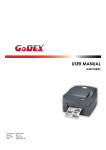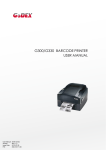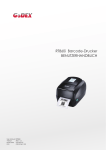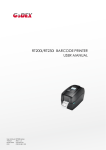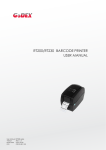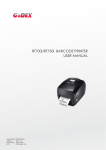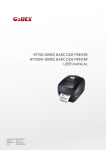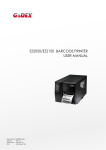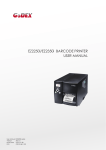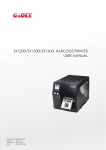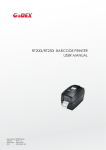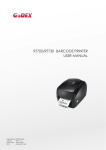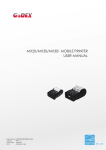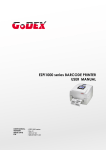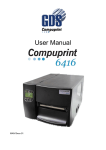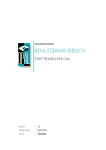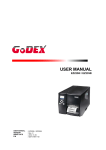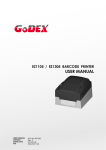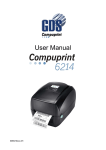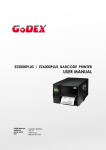Download RT860i BARCODE PRINTER USER MANUAL
Transcript
RT860i BARCODE PRINTER USER MANUAL User Manual : RT860i Version : Rev. 1.0 Issue Date : 2014.07.07 P/N : 920-015411-00 RT860i Series USER MANUAL CONTENTS 1 Barcode Printer 001 1.1 Box Content 001 1.2 Getting to Know Your Printer 002 2 Printer Setup 006 2.1 Open the Printer 006 2.2 Loading the Ribbon 007 2.3 Loading the Label Roll Module 012 2.4 Connecting the Printer to the Host Computer 014 2.5 Wizard CD Standard Installation 016 2.6 Wizard CD Other Choice Installation 019 3 Printer Setting and Control 022 3.1 Operation Panel 022 3.2 LCD Toucn Panel Introduction 023 3.3 LCD Interface Function 028 3.4 Label Calibration and Self Test 033 3.5 Error Alerts 035 3.6 USB Host 037 4 NetSetting for Ethernet 039 4.1 Installing the NetSetting Software 039 4.2 The Interface of NetSetting 041 5 Accessories 048 5.1 Preparation Steps 048 5.2 Installing the Label Dispenser 050 5.3 Installing the Cutter 056 6 Maintenance and Adjustment 060 6.1 Cleaning the Print Head 060 6.2 Troubleshooting 061 Appendix Product Specifications Interface File Manipulation When Using USB Stick Contents RT860i Series USER MANUAL FCC COMPLIANCE STATEMENT FOR AMERICAN USERS This equipment has been tested and found to comply with the limits for a CLASS A digital device, pursuant to Part 15 of the FCC Rules. These limits are designed to provide reasonable protection against harmful interference when the equipment is operated in a commercial environment. This equipment generates, uses, and can radiate radio frequency energy and, if not installed and used in accordance with the instructions, may cause harmful interference to radio communications. Operation of this equipment in a residential area is likely to cause harmful interference in which case the user will be required to correct the interference at own expense. EMS AND EMI COMPLIANCE STATEMENT FOR EUROPEAN USERS This equipment has been tested and passed with the requirements relating to electromagnetic compatibility based on the standards EN55022:2010/AC2011 Class A, EN61000-3-2:2006/A1:2009/A2:2009, EN 61000-3-3:2008 and EN55024:2010, IEC 61000-4-2:2008 series The equipment also tested and passed in accordance with the European Standard EN55022 for the both Radiated and Conducted emissions limits. RT860i TO WHICH THIS DECLARATION RELATES IS IN CONFORMITY WITH THE FOLLOWING STANDARDS IEC 60950-1:2005(2nd Edition)+Am 1:2009, CB9254-2008 (Class A ) ; GB17625. 1-2003; GB4943.1-2011, EN55022:2010/AC2011 Class A, EN61000-3-2:2006/A1:2009/A2:2009, EN 61000-3-3:2008 and EN55024:2010, IEC 61000-4-2:2008 series, UL 60950-1, 2nd Edition, 2011-12-19, CSA C22.2 No. 60950-1-07, 2nd Edition, 2011-12, CFR 47, part 15 subpart B WARNING This is a Class A product. In a domestic environment this product may cause radio interference in which case the user may be required to take adequate measures. 此为Class A产品,在生活环境中,该产品可能造成无线电干扰,在这种情况下,可能需要用户对其干扰采取切实可行 的措施。 Declaration RT860i USER MANUAL SAFETY INSTRUCTIONS Please read the following instructions carefully. 1. Keep the equipment away from humidity. 2. Before you connect the equipment to the power outlet, please check the voltage of the power source. 3. Make sure the printer is off before plugging the power connector into the power jack. 4. It is recommended that you connect the printer to a surge protector to prevent possible transient overvoltage damage. 5. Be careful not to get liquid on the equipment to avoid electrical shock. 6. For safety and warranty reasons, ONLY qualified service personnel should open the equipment. 7. Do not repair or adjust energized equipment under any circumstances. Caution **** Danger of explosion if battery is incorrectly replaced. Replace only with the equivalent type recommended by the manufacturer. **** Dispose of used batteries according to the manufacturer’s instructions. **** Only use with designated power supply adapter model. **** Changes or modifications not expressly approved by the party responsible for compliance could void the user's authority to operate the equipment. Specifications are subject to change without notice. Safety instructions 1 Barcode Printer 1.1 Box Content Please check that all of the following items are included with your printer. RT860i Barcode Printer Label Stock USB Cable RT860i Series Quick Guide RT860i Ribbon Module Empty Ribbon Core Ribbon Series Power Adapter Power Cord AC Adapter CD Including GoLabel software and user’s manual. Ribbon Hubs Set of 2. 1 1 Barcode Printer 1.2 Getting to Know Your Printer Device Overview Front View PRINTER COVER POWER BUTTON FEED BUTTON TOUCH PANEL FRONT COVER COVER RELEASE CATCHES Pull catches for opening the printer cover Rear View FAN-FOLD LABEL INSERT Feed slot for outside continuous labels PARALLEL PORT USB HOST ETHERNET PORT CALIBRATION BUTTON SERIAL PORT USB PORT POWER JACK 2 1 Barcode Printer Bottom View COVER OF THE MODULE CONNECTION JACKS **** Cut-outs are not intended for wall-mount use. Please make sure that the machine and personnel protective measures in case you need to use the wall-mount. 3 1 Barcode Printer The Internal View of Printer LABEL GUIDE PLATE Set of 2 LABEL SUPPLY HUB Set of 2 LABEL SUPPLY MODULE LABEL GUIDE Set of 2 RELEASE CATCH Release catch for opening RELEASE CATCH Release catch for closing the printer cover LABEL SENSOR MODULE LABEL SENSOR GUIDE TRACK PLATEN MODULE PLATEN PLATEN LOCKERS 4 the label supply hub 1 Barcode Printer The Printing Mechanism RIBBON REWIND MECHANISM COVER The cover for Ribbon rewind mechanism NOTCH OF RIBBON REWIND WHEEL RIBBON REWIND WHEEL PRINT HEAD RIBBON SUPPLY MECHANISM PAPER PRESS BAR NOTCH OF RIBBON SUPPLY WHEEL RIBBON SUPPLY WHEEL 5 2 Printer Setup 2.1 Open the Printer Open the Printer Cover and the Printing Mechanism Place the printer on a flat surface. Open the printer cover by pulling the cover release catches on both sides of the printer and lift the printer cover. Pull the catches toward the direction Pull the catches toward the direction COVER RELEASE CATCHES Pull the catches for opening the printer cover The printing mechanism is lifted up with the printer cover 6 2 Printer Setup 2.2 Loading the Ribbon A New Ribbon Module Installation A NEW RIBBON 1. EMPTY RIBBON CORE RIBBON HUB Attach the ribbon to the empty ribbon core with the adhesive strip at the end of the ribbon. Stick on empty ribbon core 2. Insert the ribbon hub into empty ribbon core and new ribbon. Wind the ribbon around the empty ribbon core for 2 to 3 circles. Insert the ribbon hub Wind the ribbon around the core 3. A ribbon module is assembled as below. A NEW RIBBON MODULE RIBBON SUPPLY RIBBON REWIND 7 2 Printer Setup Load the Ribbon on the Printer For Ribbon Supply Module RIBBON SUPPLY MECHANISM NOTCH OF RIBBON SUPPLY WHEEL RIBBON SUPPLY WHEEL 1. Place the ribbon supply module into the printing mechanism. Please the left-hand side of ribbon hub first. Make sure the holder of ribbon hub is inserted into the notch. Then place the right-hand side of ribbon hub. Left side RIBBON SUPPLY MODULE Place 放入 Place HOLDER NOTCH OF RIBBON SUPPLY WHEEL Right side HOLDER Place 8 NOTCH 2 2. Printer Setup Unlock the release catch to close the printer cover. Push the release catch forward to unlock it. The ribbon supply module loading is completed. 2 1 Close the printer cover Push RELEASE CATCH Release catch for closing the printer cover Load the Ribbon on the Printer For Ribbon Rewind Module RIBBON REWIND MECHANISM COVER The cover for Ribbon rewind mechanism NOTCH OF RIBBON REWIND WHEEL RIBBON REWIND WHEEL 9 2 1. Printer Setup Open the cover of ribbon rewind mechanism. Open the cover 2. Place the ribbon rewind module into the ribbon rewind mechanism. Please the left-hand side of ribbon hub first. Make sure the holder of ribbon hub is inserted into the notch. Then place the right-hand side of ribbon hub. Place Left side Place Place HOLDER NOTCH OF RIBBON REWIND WHEEL RIBBON REWIND MODULE Right side HOLDER Place 10 NOTCH 2 3. Printer Setup Turn the ribbon rewind wheel to tighten the ribbon until it has no wrinkles. Rotate backward RIBBON REWIND WHEEL 4. Close the cover of ribbon rewind mechanism. The ribbon loading is completed once the ribbon supply module and ribbon rewind module are assembled correctly. Close the cover 11 2 Printer Setup 2.3 Loading the Label Roll Module Loading the Label Stock on the Printer LABEL GUIDE PLATE Set of 2 LABEL SUPPLY HUB Set of 2 LABEL SUPPLY MODULE LABEL STOCK LABEL GUIDE Set of 2 RELEASE CATCH Release catch for opening 1. Unlock the ribbon catch and pull to open the label guide plate. Pull to open 2 the label supply hub 2 LABEL GUIDE PLATE Set of 2 RELEASE CATCH Release catch for opening the label supply hub 1 2. Place the label stock on label supply hubs. Make sure the label stock is aligned to both hubs. Adjust the label guide plates to fix the label width. Remember to push the release catch when moving the label guide plates. Place Close the plates 12 2 3. Printer Setup Feed the Label through the label guides. The label guides will help to prevent the label swaying. Through the label guides LABEL GUIDE Set of 2 4. Unlock the release catch to close the printer cover. 2 Close the printer cover 1 RELEASE CATCH Release catch for closing the printer cover 5. Press the FEED key and make sure the label is fed smoothly. The label loading is completed now. Note **** Please keeps the rack gear clean to ensure the smoothness of label holder. 13 2 Printer Setup 2.4 Connecting the Printer to the Host Computer 1. Please make sure that the printer is switched off. 2. Connect the power cord to the AC adapter. POWER CORD AC ADAPTER Connect the jack of the power adapter to the printer and connect the plug of the power adapter to the socket of the wall. RT860i BARCODE PRINTER POWER ADAPTER JACK SLOT THE WALL PLUG 14 SOCKET 2 3. Printer Setup Connect the USB/serial cable to the printer and host computer. RT860i BARCODE PRINTER USB PORT USB CABLE PLUG PLUG PC SOCKET 4. Pressing the power button. The Touch Panel LCD will lights up. Pressing the power button TOUCH PANEL LCD 15 2 Printer Setup 2.5 Wizard CD Standard Installation 1. Insert the Super Wizard CD in the CD/DVD drive of the host computer and the installation program should pop up automatically. You will see the Welcome screen first. On the Welcome screen, choose “STANDARD INSTALLATION”. 2. The wizard will then ask you to make sure your USB and power cables are connected and that the power is turned on. Then click “NEXT”. 3. The next screen you will see is, “Install the GoLabel Software and Windows driver”. Click “NEXT” to continue. Note * If the Super Wizard program did not run automatically, you can either turn on the “Auto-run” setting for your CD/DVD driver or double-click the icon of CD/DVD driver to run the program manually. 16 2 4. Printer Setup As the printer driver and GoLabel are installing, a screen will display a progress bar. While downloading completed you will see Installation completed. Click “NEXT” to continue. 5. You can also print a test label. If don’t print a test label, the screen display as step 6. Note * If you need more resources, tools or reference documents, you can also find them on Super Wizard CD. Just click “Other Choices” on the Welcome Screen to access the files. 17 2 6. Printer Setup Once the installation is complete, you can start to make and print labels with GoLabel or through the printer driver. 18 2 Printer Setup 2.6 Wizard CD Other Choice Installation 1. Click “OTHER CHOICES” to next screen and select “PRINTER DRIVERS”. 2. Click “INSTALL SEAGULL SCIENTIFIC WINDOWS DRIVER” to next screen, and click “NEXT”. 3. Select “I accept the terms in the license agreement”, and click ”Next”,then click ”Finish” to step 4. 19 2 Printer Setup 4. The Driver Wizard will guide you through the installation procedure. Select "Install printer drivers" and click “Next”. 5. With a USB connection, search models such as the right diagram printer device. Specify your printer model and click ”Next”. 6. Enter the printer name (you can use default), then click "Next" to display as right diagram. Click "Finish" button to start installation. 20 2 Printer Setup 7. Driver installation completed. 21 3 Printer Setting and Control 3.1 Operation Panel OPERATION TOUCH PANEL POWER BUTTON FEED BUTTON TOUCH PANEL POWER Button Press the POWER button to turn on the printer, and the START UP SCREEN appears. The printer is on “ready to print” status, the LCD screen should display the message “READY“ on the screen. When printer is turned on, hold and press down the POWER button for 3 second will turn the printer off. FEED Button When you press the FEED button, the printer will advance media until the FEED button is released. If you are using continuous labels, pressing the FEED button will advance a length of media until the button is released. If you are using media with gaps, pressing the FEED button once will advance only one label. If the label does not stop at the correct position, you need to run the auto-detection function for your media, please see Section 3.4 Label Calibration and Self-Test. PAUSE PRINTING_FEED Button Pressing the FEED button during printing will interrupt printing, and the LCD display message “PAUSE...”. When the FEED button is pressed again, the printer resumes printing. Example: While a 10-label print job is running, you press the FEED button to pause the printer. Two of the labels have been printed. To resume printing and print the remaining eight labels, you will need to press the FEED button again. CANCEL PRINTING_FEED Button Press and hold the FEED button for 3 seconds during printing, the current print job will be cancelled. Example: While a 10-label print job is running, you press the FEED button. Two of the labels have been printed. The print job is cancelled and the remaining eight labels will not be printed. 22 3 Printer Setting and Control 3.2 LCD Interface Introduction Getting Started Press the POWER button to turn on the printer, and the START UP SCREEN appears. Power on 2.004-140617 If the printer is on “ready to print” status, the LCD screen should display the message “Ready“ on the screen. Use touch gestures to get around the main screen and other screen for setting. Tap the screen with your finger when you want to select on screen items such as settings icons. RT860i V2.004 Main Wizard Test 23 3 Printer Setting and Control On the Ready Page, three function mode for setting. You can make various setting functions in FUNCTIONAL MODE. Main RT860i V2.004 Printer Settings LCD Language Codepage Tap‘’Main ‘’-Screen could show more detail of‘’ Main‘’ Label Settings Main Wizard Test Printer Control Devices Recall Label Wizard RT860i V2.004 Main Wizard Test Darkness 10 Speed 6 Media Type Continuous X-Offset 0 Y-Offset 0 Tap‘’Wizard ‘’-Set up printer of ‘’Darkness’’ ‘’Speed ‘’... Test Self-Test page RT860i V2.004 Tap‘’Test ‘’-- Calibration Self-Test page and Calibration for setting. Main Wizard Test 24 3 Printer Setting and Control Main Printer Settings Darkness 10 Speed 6 Sensor Select Auto Select Media Type finish setting tap back to Main page, if do not save, tap LCD Language Codepage Label Settings Devices Printer Control system back to Main page and Continuous Printer Settings would not save any changes. Recall Label Printer Settings Darkness 10 Speed 6 Sensor Select Auto Select Media Type Continuous UNLOCK LOCK If printer functions locked, printer can not modify settings from GoLabel or any devices. 25 3 Printer Setting and Control Keyboard Mode When plug-in an USB keyboard to the printer, LCD touch panel will display “Enter Standalone”, press the “Y” key on keyboard to entering to the dialog for “Keyboard Mode” operation. Keyboard Mode RT860i V2.004 Enter Standalone Recall Label Country Code Codepage Clock Setting Database Setting Label Edit (Y/N) Preview Label function User can choose any labels to preview it before print it. Main RT860i V2.004 From the “Ready” page, tap to Main page Printer Settings LCD Language Codepage Label Settings Devices Printer Control Main From the Main page tap Recall Label to Recall Label page. Main Wizard 26 Test Recall Label 3 Printer Setting and Control Recall Label Recall Label From the Recall Label Page 001/002 FORM NAME 5 0° 5 0 15 0 LABEL-1 LABEL-2 RT860i 5 0° the touch panel shown on all labels, 5 0 Tap up to choose labels. 0 Tap down to choose labels. FW:V2.004 15 Preview Label Preview Label Tap Preview Label can see printing label. Preview Label Recall Label Print Quantity Keeping tap 1 to next page Print out selected label. 5 0° 60i RT8 04 2.0 V : FW 27 3 Printer Setting and Control 3.3 LCD Interface Function Main Page Main Printer Settings LCD Language Codepage Label Settings Devices Printer Control Recall Label Setting items for printer, ex. Printing speed, darkness. Also includes a Printing Wizard for your ease of printing. 10 languages for printer setting It consists of a table of values that describes the character set for a particular language Setting items for printing label, ex. Rotation, Printing position offset Providing Buzzer, Option Setting, Smart Backfeed, Serial Port Setting, LAN Setting, LCD Setting, Clock Setting, WiFi Setting, and Bluetooth Setting Self-Diagnose functions for printer, ex. Calibration, Self-Test page and Clear Memory Recall Label and preview label 28 3 Printer Setting and Control Device Page Device Main Printer Settings LCD Language Codepage Buzzer Option Setting Smart Backfeed Label Settings Devices Printer Control Serial Port Setting LAN Setting LCD Setting ® Clock Setting Recall Label WiFi Setting Bluetooth Setting Setting off or on for buzzer Setting items for options, ex. Cutter, Label Dispenser, Applicator Setting off or on for Preview Label Setting items for Serial Port, ex. Baud Rate, Parity, Data Bits, Stop Bits. Setting items for LAN, ex. DHCP, IP Address, Subnet Mask, Gateway Setting items for LCD, ex. off or on for Password function, Correction Setting items for Clock, ex. Year, Month, Day, Hour, Minute and off or on for Visible function 29 3 Printer Setting and Control Setting Items in LCD Setting Mode Darkness Speed Sensor Select Media Type Printer Settings Printing Mode Tear-off Position Top of Form Program Language 0-19 2-3 Auto Select See-Through Reflective Label with Gaps Label with Marks Continuous Direct Thermal Thermal Transfer 0-40 OFF FULL Door Open Only Auto EZPL GEPL GZPL English Deutsch Français Español Italiano LCD Language 簡體中文 繁體中文 Türkçe 日本語 Pусский 850 852 437 860 863 865 857 861 862 855 866 737 851 869 Windows 1252 Windows 1250 Windows 1251 Windows 1253 Windows 1254 Windows 1255 Windows 1257 Rotation (0°、90°、180°、270°) X-Offset (-100 ~ +100) Y-Offset (-100 ~ +100) Start Offset (-100 ~ +100) Code Page Label Settings 30 3 Printer Setting and Control Buzzer Option Setting Smart Backfeed OFF ON None Cutter Label Dispenser Applicator OFF ON Baud Rate Serial Port Setting Parity Data Bits Devices Stop Bits DHCP IP Address Subnet Mask Gateway LAN Setting Password LCD Setting 4800 9600 19200 38400 57600 115200 None Odd Even 7 8 1 2 OFF/ON 0.0.0.0 255.255.255.0 192.168.0.254 OFF / ON Correction Clock Setting Year Month Day Hour Minute Visible OFF/ON Configuration Test Sample Pattern Select Memory Printer Control Directory TPH Testing Dump Mode Self-Test page / Balance Internal / External Label Format Clear Memory Graphic Bitmap Fonts Ture Type Fonts Asian Fonts ALL Calibration Reset to Default Darkness Speed Wizard X-Offset 2-3 Label with Gaps Label with Marks Continuous -100 ~ +100 Y-Offset -100 ~ +100 Media Type 31 0-19 3 Printer Setting and Control Status of LCD Interface When printer is on standby status (ready to print), the LCD interface will display “Ready” on screen. You can only print when you see the “Ready“ status. RT860i V2.004 Main Wizard Test If there is any printers error, the LCD screen will display the error screen to show the type of error. You can fix the error according the notice or contact the supplier. WARNING ICON RT860i V2.004 ERROR ICON Check Media ERROR DESCRIPTION RT860i V2.004 Any support needed please contact your supplier 32 3 Printer Setting and Control 3.4 Label Calibration and Self Test Label Calibration The printer can automatically detect and store label height. That means the host computer does not need to transmit the label height to the printer. Self Test Self-test function lets you check whether the printer is functioning normally. Here is how you run the label size calibration and self test. 1. Check that the label stock is loaded correctly. 2. urn off the printer and pressing the FEED button. 3. Turn the printer on again, keeping the FEED button pressed. When the LED starts to flash red, release the FEED button. The printer will now measure the label stock and store the label height. 4. Once the printer has successfully measured the label stock, it will print a self-test label. The contents of a self-test printout are listed below. RT860i VX.XXX Model & Version USB S/N:12345678 USB ID setting Serial port:96,N,8,1 Serial port setting MAC Addr:xx-xx-xx-xx-xx-xx MAC address of Ethernet port IP address setting IP xxx.xxx.xxx.xxx (DHCP_10MF) Gateway setting Gateway xxx.xxx.xxx.xxx Sub-Mask setting Sub-Mask xxx.xxx.xxx.xxx PORT State L S E U B Port status 11111 (The default value is 1, which means that all ports open) ########################## 0000 FORM(S) IN MEMORY Number of forms 0000 GRAPHIC(S) IN MEMORY Number of graphics 000 FONT(S) IN MEMORY Number of fonts Number of Asian fonts 000 ASIAN FONT(S) IN MEMORY Number of Databases 000 DATABASE(S) IN MEMORY 000 TTF(S) IN MEMORY Number of Scalable fonts 63980 KB FREE MEMORY Free memory size ^S3 ^H8 ^R000 ~R200 ~Q+0 Speed, Density, Ref. Point, Print direction Label width, Form length, Stop position ^W102 ^Q100,3 ^E16 Cutter, Label Dispenser, Mode Option:^D0 ^O0 ^AT Ref.:0.4 2.8 1.4 [2.4_8] Sensor Setting Code Page:850 Code Page 33 3 Printer Setting and Control Label Calibration Button A hardware button to make a Label Calibration while printer encountering ‘’Media Error’’ during the cases when first-time printer start up or change label to another type, such as change using gap label to continuous or black mark labels. CALIBRATION BUTTON Press and hold about 1 ~ 2 seconds Press Calibration button for 1 ~ 2 seconds, it will make an auto-sensing to calibrate the label’s parameters. Press and hold about 1 ~ 2 seconds Note ****Press Calibration button is equivalent to the auto-sensing command ‘’~S,SENSOR’’ that will cancel on-printing-job and make the Label Calibration immediately. 34 3 Printer Setting and Control 3.5 Error Alerts In the event of a problem that prevents normal functioning of the printer, you will see an error message on LCD screen and hear some beep signals. Please refer to below table for the error alerts. OPERATION TOUCH PANEL POWER BUTTON FEED BUTTON TOUCH PANEL Operation Panel Status Type Beeps RT860i V2.004 Door Open Only 2 x 4 beeps Door Open Only Description Solution The printing Open the print mechanism is not mechanism and correctly closed. close it again. Once the print RT860i V2.004 TPH Over Heat None High temperature at the print head. TPH Over Heat down, the printer switches to standby mode. No ribbon is Make sure that installed and the the printer is set to printer displays an direct thermal RT860i V2.004 error. Check Ribbon head has cooled Media Error printing mode. 2 x 3 beeps The ribbon is finished or the Replace the label supply hub is ribbon roll. 35 not mov ing. 3 Printer Setting and Control Operation Panel Status Satus Beeps Description Solution Make sure that the label sensor is positioned No paper is detected. correctly. If the sensor still does not detect the paper, run the autodetection RT860i V2.004 function again. Paper is finished. Check Media Media Error 2 x 2 beeps Replace the label roll. Possible reasons: the print medium has become trapped around the rubber roll; the Printer feed sensor cannot problem. detect a gap or black mark between the labels; there is no paper. Please reset the sensor. RT860i V2.004 The memory is full. The printer prints File System Full the message "File System full ". Delete unnecessary data or install additional memory. Use the "~X4" command to print RT860i V2.004 Unable to find file. all files. Then File Not Found File Error 2 x 2 beeps The printer prints check whether the message "File the files exist and not found" whether the names are correct. A file of the same RT860i V2.004 name already exists. The printer Duplicated Name prints the message "Duplicated Name". 36 Change the name of the file and try storing it again. 3 Printer Setting and Control 3.6 USB Host Definition : USB Host port supports either device:USB memory stick, USB keyboard or scanner. Purpose USB memory stick : It extends the user memory space for Graphic, Font, Label Format, DBF and Command files downloading. The printer’s Firmware also can be updating if copy new version of Firmware into USB memory stick. Connecting an USB keyboard to printer for ‘’Keyboard Mode’’ mode operation. Plug-in an USB scanner to operate the printer in ‘’Keyboard Mode’’ . Usage of Extended Memory USB memory stick : It supports hot-plugging function; printer will create a Folder ‘’\LABELDIR’’ and switch ‘’User Flash’’ to ‘’ Extended Memory‘’ automatically while user plugs an USB memory stick into a GoDEX printer. Connect USB with the printer; To connect PC and printer through USB. Usage of Firmware Update Remove USB memory stick from printer and plug-in it to a PC’s USB port. Copy a new version of Firmware ‘’xxxx.bin’’ to the Folder ‘’\LABELDIR\FW’’ Remove USB from PC and plug-in back to the printer. The printer will update the Firmware automatically The "\ LABELDIR \ FW" directory allows only one file exists, if there are multiple files, the files will be confused. Don’t remove the USB memory stick out while it’s under updating with ‘’Flash Writing...’’message that displays on LCD panel. 37 3 Printer Setting and Control USB Keyboard When plug-in an USB keyboard to the printer, LCD touch panel will display “Enter Standalone”, press the “Y” key on keyboard to entering “Keyboard Mode” operation. Under this model can perform "Recall Label", set "Country Code", "Code Page", "Clock Setting", "Database Setting" and "Label Edit". Connect a USB keyboard to the printer, if not into the keyboard mode, press the "N" key to leave. Into Standalone mode of operation, to leave the Standalone operation, press "ESC" key to exit. After leaving the keyboard mode, for re-entry, press the keyboard "F1" key or reboot, you can follow the steps in the first step choose whether or not (Y / N) into the keyboard mode. Scanner When plug-in an USB scanner to the printer, LCD touch panel will display “Enter Standalone”, tap the “Feed” Key to entering “Keyboard Mode” operation. Note ** The USB Host port on printer is not support ‘’USB HUB’’ function. ** The USB Memory Stick supports with ‘’FAT32’’Disk Format and up to 32GB only. The certified venders are Transcend, Apacer, ADATA, Patriot, Consair and Kingston. ** The USB Memory Stick only supports download through the printer, On a PC, user may copy entire folder “\LABELDIR” from USB memory stick to PC or vice-versa. Can not copy the data to USB Memory Stick via PC individually. ** External USB Host port is for power 500mA, is not recommended as electronics charging use. 38 4 NetSetting for Ethernet 4.1 Installing the NetSetting software The NetSetting software is used to manage the network configurations when connecting the printer via Ethernet port. It is available on product CD or can be downloaded from official website. To install the NetSetting, please follow below steps. 1. Insert the product CD in the CD/DVD drive, and click “OTHER CHOICES” buttom. 2. Select “ETHERNET”. 3. Click "Install Ethernet NetSetting Software", installation screen as right diagram, click "Next". 4. Specify the “Installation Folder", then click ”Next” to installing. 39 4 5. NetSetting for Ethernet Once the installation is completed, you will see the NetSetting icon on your desktop as right diagram. NetSetting 40 4 NetSetting for Ethernet 4.2 The Interface of NetSetting GoDEX printer can also be used through a network connection (as a remote network printer), make sure the printer connected to the Internet and the power cord, you can use the Interface of NetSetting to search connected network printers. 1. Click the NetSetting icon to start the program, you will see the start page as left diagram. Click the magnifier icon to search the Godex printers which are connected via Ethernet port in you network environment (as right diagram). 2. There are six tabs on the top of interface which can configure different types of network settings. But for the data security reason, you need correct password to enter the configuration pages. Note * The default password is “1111”, you can change the password later from the “IP Setting” tab. 41 4 NetSetting for Ethernet IP Setting The IP Setting tab can change the printer name, Port number, Gateway setting and the password for configuring theprinter. You can also set the printer’s IP address ether by DHCP or by Static IP. You can press “Set” button to apply the settings and “ReGet” button to refresh the setting values. 42 4 NetSetting for Ethernet Alert Path Setting NetSetting will send the alert messages to designated mail account when the error happened on printer. The alertmessages are sent by SMTP (Simple Mail Transfer Protocol) or SNMP (Simple Network Management Protocol). You can set or change the configurations of SMTP and SNMP on this “Alert Path Setting” tab. You can press “Set” button to apply the settings and “ReGet” button to refresh the setting values. 43 4 NetSetting for Ethernet Alert Message Setting For the alert message notification function, you can decide which error cases need to be sent out to the operator. Moreover, the alert messages can be set to be sent by SMTP, SNMP or both. You can press “Set” button to apply the settings and “ReGet” button to refresh the setting values. 44 4 NetSetting for Ethernet Printer Configuration Set or change the configurations of connected printer. Most of key settings for the printer operation can be done by this setting page. You can press “Set” button to apply the settings and “ReGet” button to refresh the setting values. 45 4 NetSetting for Ethernet User Command The “User Command” tab provides a communication interface for operator to control the printer. Input printer commands in "Input Command" window and press “Send Command” button, the commands will be sent to the printer. For some commands that will return response message, the message will be displayed in "Output Message" window. You can press “Send Command” button to send printer commands via Ethernet port and control the printer remotely. 46 4 NetSetting for Ethernet Firmware Download On “Firmware Download” tab, the current version of printer firmware will be showed on the screen. If you need to update the printer firmware, just specify the file location of firmware file and press “Start Download Firmware” button. The printer firmware then can be updated remotely. In addition to the firmware update, you can press “Recover To Factory Settings” button to restore the printer configurations back to factory default. 47 5 Accessories 5.1 Preparation Steps Before installing the optional modules, please make some preparations as follows. 1. Turn off the printer : Remember to switch off the printer before installing any module. 2. Open the printer cover and the printing mechanism : Open the printer cover by pulling the release catches on both sides of the printer and lift the cover. Please see the Section 2.1 for further information about Open the Printer. The printing mechanism is lifted up with the printer cover 3. Remove the front cover : Please pull upward to remove the front cover. Pull upward FRONT COVER 48 5 4. Accessories Remove the platen : Lift up the release clips on both sides of the platen to release and pull upward the platen. Release the clip CLIP PLATEN MODULE Pull up the platen module 5. Ribbon loading : 6. Label loading Please see the Section 2.2 for further information about Loading the Ribbon. Please see the Section 2.3 for further information about Loading the Label Roll Module. 49 5 Accessories 5.2 Installing the Label Dispenser The Overview of the Label Dispenser PAPER SENSOR PAPER FEED ROLLER CONNECTION CABLE OF LABEL DISPENSER FRONT COVER Preparation Steps Please see the Section 5.1 Preparation Steps to complete the preparation steps before installing the label dispenser. Installing the Label Dispenser 1. Pass the connection cable through the slot of the printer. SLOT **** A label liner thickness of 0.06 mm ± 10% and a weight of 65 g/m2 ± 6% are recommended. **** The label dispenser will take labels up to a max. width of 118 mm. **** When using the label dispenser, set the stop position (printer command ^E) to 13. 50 5 2. Accessories Place label dispenser to align both holes of screw and then tighten the screws. (Screw holes on the front side of the bottom barcode Printer) 1 2 Tighten the screw 3. Place the platen back to the printer and lock the clips. Screw Hole Lock the clip CLIP 4. Close the printer cover and printing mechanism. Then to turn the printer upside down. 2 Close the printer cover 1 Push RELEASE CATCH Release catch for closing the printer cover 51 Open the front cover 2 5 5. Accessories Open the cover on the bottom of printer. COVER OF THE MODULE CONNECTION JACKS Open the cover 6. Plug the connector fo the label dispenser to the jack. Plug JACK CONNECTOR OF THE CONNECTION CABLE 7. Close the cover of the module connection jacks. COVER OF THE MODULE CONNECTION JACKS Close the cover Note ****The printer must be switched off when plugging the connector, or the motherboard may be destroyed! ****There are 2 jacks : the lower jack for the label dispenser, the upper jack for the cutter. CUTTER JACK LABEL DISPENSER JACK 52 5 Accessories Loading Label Roll with the C Module 1. Remove the first label from the label stock. LABEL STOCK LABEL LINER Tear a label THE FIRST LABEL 2. Feed the Label stock through the label guides. And pull the label liner through the platen and the steel of the label dispenser. Through the label guides Through the platen and the steel STEEL PLATEN * With Label Dispenser, the labels should be at least 25 mm high. 53 LABEL LINER 5 3. Accessories The feeding path of label and liner should be as shown in below graphic. LABEL LABEL LINER LABEL STOCK PLATEN ROLLER 4. Close the label dispenser and printer cover. The installation is completed now. Close the cover 54 5 5. Accessories Press the FEED button to feed the label. The label will be peeled from the liner while it passes through the label dispenser. Press the feed key LABEL LABEL LINER **** There is a paper sensor on the Label Dispenser module. It will stop the printing if it is covered by label. Remove the last printed label and the printer will then continue to print next label. PAPER SENSOR 55 5 Accessories 5.3 Installing the Cutter The Overview of the Cutter CONNECTION CABLE OF CUTTER FEED-OUT SLOT COVER Preparation Steps Please see the Section 5.1 Preparation Steps to complete the preparation steps before installing the cutter. Installing the Cutter 1. Pass the connection cable through the slot of the printer. SLOT ****Remember to switch off the printer before installing the cutter. ****Do not use to cut adhesive labels! Glue residue will be left on the cutter blade and impair its functioning. The cutter has a blade life of 400,000 cuts when using paper liner which is 250μm thick and 76.2mm (3 inches) wide. ****You can cut paper with a max. width of 118mm. ****With the cutter installed, set the stop position in Qlabel to 30, and the E value to 30. 56 5 2. Accessories Place the cutter to align both holes of screw and then tighten the screws. (Screw holes on the front side of the bottom barcode Printer) Tighten the screw 3. Screw Hole Place the platen back to the printer and lock the clips. Lock the clip CLIP 4. Close the printer cover and printing mechanism. Then to turn the printer upside down. 2 Close the printer cover 1 Push RELEASE CATCH Release catch for closing the printer cover 57 2 5 5. Accessories Open the cover on the bottom of printer. COVER OF THE MODULE CONNECTION JACKS Open the cover 6. Plug the connector for the cutter to the jack. Plug JACK CONNECTOR OF THE CONNECTION CABLE 7. Close the cover of the module connection jacks. COVER OF THE MODULE CONNECTION JACKS Close the cover ****The printer must be switched off, or the motherboard may be destroyed! ****There are 2 jacks : the lower jack for the label dispenser, the upper jack for the cutter. CUTTER JACK LABEL DISPENSER JACK 58 5 Accessories Installing the Label Roll Module on the Printer 1. Pass the labels through the guides and the cutter. Through the label guides Through the cutter 2. Close the top cover and printing mechanism. To finish, press the FEED button to set the label position. 2 Close the top cover 1 Push Press the feed key RELEASE CATCH Release catch for closing the printer cover ****We advise against using inside wound label stock. ****Labels should be at least 30 mm high. When using the printer with the cutter, you should set the stop position (^E) to 30. 59 6 Maintenance and Adjustment 6.1 Cleaning the Print Head Dirt on the print head or ribbon may result in inadequate print quality (there are only partial images on the label). The printer cover should therefore be kept closed when possible. Keeping dirt and dust away from the paper or labels ensures a good print quality and a longer lifespan of the print head. Cleaning Steps 1. Switch off the printer. 2. Open the printer cover. 3. Remove the ribbon. 4. To remove any label residue or other dirt from the print head (see Red arrow), please use a soft lint-free cloth dipped in alcohol to wipe. PRINT HEAD To clean the print head ****Weekly to clean the print head one time. (Recommended) ****When cleaning the print head, please note that if there is attached to metal or hard on soft cloth, if using a dirty soft cloth made printer head damage is not covered under warranty conditions. 60 6 Maintenance and Adjustment 6.2 Troubleshooting Problem The printer is switched on but the LED does not light up. The LED lights up red and printing is interrupted. Solution ♦ Check the power supply. Please see the Section 2.4 ♦ Check the software settings (driver settings) or command codes. ♦ Look for the error alert in the table in Section 3.3. Error Alerts. ♦ Check whether the print mechanism is closed correctly. Please see the Section 3.3 The label stock passes through the printer but no image is printed. ♦ Please make sure that the label stock is loaded the right side up and that it is the suitable material. ♦ Choose the correct printer driver. ♦ Choose the correct label stock and a suitable printing mode. ♦ Clear the paper jam. Remove any label material left on the thermal print head and clean the print head using a soft lint-free cloth dipped in alcohol. The label stock jams during printing. Please see the Section 6.1 There is no printed image on some parts of the label. There is no printed image on part of the label or the image is blurred. The printed image is positioned incorrectly. Skipping labels during printing. ♦ Check whether there is any label material or ribbon stuck to the thermal print head. ♦ Check for errors in the application software. ♦ Check whether the starting position has been set correctly. ♦ Check the ribbon for wrinkles. ♦ Check the power supply is correct ♦ Check the thermal print head for dust or other dirt. ♦ Use the internal “~T” command to check whether the thermal print head will carry out a complete print job. ♦ Check the quality of the print medium. ♦ Check whether there is paper or dust covering the sensor. ♦ Check whether the label stock is suitable. Contact your supplier. ♦ Check the paper guide settings. ♦ Check the label height setting. ♦ Check whether there is dust covering the sensor. ♦ Run the auto-detection function. Please see the Section 3.2 The printed image is blurred. ♦ Check the darkness setting. ♦ Check the thermal print head for dust or dirt. Please see the Section 6.1 The cutter does not cut off the labels in a straight line. ♦ Check whether the label stock is positioned straight. The cutter does not cut off the labels completely. ♦ Check whether the label is more than 0.2 mm thick. When using the cutter, the labels are not fed through or cut off incorrectly. ♦ Check whether the cutter has been correctly installed. ♦ Check whether the paper guides are functioning correctly. The label dispenser is not functioning normally. ♦ Check whether there is dust on the label dispenser. ♦ Check whether the label stock is positioned correctly. Note **** If this does not resolve the problem, contact your dealer. 61 RT860i USER MANUAL APPENDIX PRODUCT SPENIFICATIONS 128 MB Flash (60 MB for user storage) Adjustable reflective sensor (full range). Fixed transmissive sensor, central aligned. Min. 1” (25.4 mm) Max. 4.64” (118 mm) Max. 0.008” (0.20 mm) 360” (110 m) Windows XP, Vista, Win7, Server 2003 & 2008 Windows XP, Vista, Win7, Server 2003 & 2008 Serial port: RS-232 (DB-9) USB 2.0 Device port (B-Type) IEEE 802.3 10/100Base-Tx Ethernet port (RJ45) USB Host (A-Type) Parallel Port (Mini-Centronics) 122 50 280 mm (11.0”) 195 mm (7.7”) 210 mm (8.3”) Label dispenser with label taken sensor module Cutter module External label unwinder External label rewinder Bluetooth module (distributor install) WiFi printer server module (distributor install) Appendix RT860i USER MANUAL APPENDIX Communication Port Specifications Pinout Description Power Jack USB Port Serial Port Ethernet Port 1 2 1 3 4 • USB Port USB Host 8 Parallel Port 1 5 4 3 2 1 18 1 36 19 4 9 8 7 6 Connector Type : Type B Pin NO. 1 2 3 NC D- D+ • Serial Port 4 GND Default Settings : Baud rate 9600, no parity, 8 data bit, 1 stop bit, XON/XOFF Protocal and RTS/CTS RS232 Housing (9-pin to 9-pin) Pin NO. 1 2 +5V, max 500mA TXD - • Ethernet Port Pin NO. RXD 3 4 5 6 7 8 9 Type RXD N/C GND RTS CTS RTS N/C DB9 Plug TXD DTR GND DSR RTS CTS RI DB9 Socket Type : RJ45 1 2 3 4 5 6 7 8 TX+ TX- RX+ NC NC RX- NC NC • USB Host Connector Type : Type A Pin NO. 1 2 3 VBUS D- D+ • Parallel Port Pin NO. 1 BUZY Pin NO. 19 GND 4 GND Type : Centronics Female 2 3 4 5 6 7 8 SELECT ACK FAULTN LPT PERR DATA0 DATA1 DATA2 9 DATA3 10 DATA4 11 DATA5 12 13 14 15 16 17 18 DATA6 DATA7 LPT INTN STROB SELIN AUTO NC 20 21 22 23 24 25 26 27 28 29 30 31 32 33 34 35 36 GND GND GND GND GND GND GND GND GND GND GND GND GND GND GND GND 5V Note ****Serial port total output can not exceed the maximum current of 500mA Appendix RT860i USER MANUAL APPENDIX FILE MANIPULATION WHEN USING USB STICK File Manipulation The files in both devices (USB memory stick and printer internal Flash memory) are able to copy and move by the commands ‘’~MCPY’’ and ‘’MMOV’’ that sends from GoLabel on a PC via either connection - USB or Ethernet ports. Copy Syntax ~MCPY,s:o.x,d:o.x Description Copy file from USB memory stick to Flash memory, or vise-versa Parameter s = source device of stored object; “D” for USB memory stick; “F” for internal Flash memory d = destination device of stored object “D” for USB memory stick; “F” for internal Flash memory o = object name (file name); the name “o” is substituted for “*” x = extension (file type), the type “x” is substituted by ”*”, or following either one: D= database, A= Asia font, C= TTF font, E= Bit-Mapped font, F= label format, G= graphic, S= serial file, T= text, B= Unicode Table. Example ~MCPY,F:*.F,D:*.F (Copy entire “Label Format” files from Flash memory to USB memory stick) ~MCPY,D:*.G,F:*.G (Copy entire “Graphic” files from USB memory stick to Flash Memory) ~MCPY,D:*.*,F:*.* (Copy all object files from USB memory stick to Flash Memory) Move Syntax ~MMOV,s:o.x,d:o.x Description Move files from USB memory stick to Flash memory or vise-versa Parameter s = source device of stored object; “D” for USB memory stick; “F” for internal Flash memory d = destination device of stored object “D” for USB memory stick; “F” for internal Flash memory o = object name (file name); the name “o” is substituted for “*” x = extension (file type), the type “x” is substituted by ”*”, or following either one: D= database, A= Asia font, C= TTF font, E= Bit-Mapped font, F= label format, G= graphic, S= serial file, T= text, B= Unicode Table. Example ~MMOV,F:*.F,D:*.F (Move entire “Label Format” files from Flash memory to USB memory stick) ~MMOV,D:*.G,F:*.G (Move entire “Graphic” files from USB memory stick to Flash Memory) ~MMOV,D:*.*,F:*.* (Move all object files from USB memory stick to Flash Memory) Appendix




































































